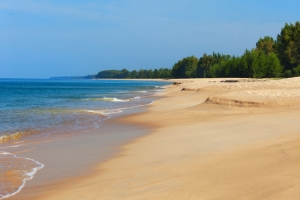
A beach cusp is a formation of sand, gravel or other beach material in the form of an arc. The cusp is the point of the arc on each side, directed toward the ocean. A beach cusp can refer to the point or to the entire formation, including the arc with points at each end. Beach cusps normally occur in a row along the beach, having the same size and spacing in a regular pattern.
Beach cusps are more likely to form on beaches that have coarse material like pebbles. Although wave action causes the formation of beach cusps, the process is not fully understood. One theory suggests the frequency of wave patterns may help to create them.
When incoming waves meet a flow of water returning seaward from a previous wave, this generates waves that move toward the left and right, parallel to the shoreline. They can move in opposite directions. When they collide, this can increase the height of an incoming wave. The frequency of these wave patterns may produce the arcs and beach cusps.
They usually found to be from 10 to 20 feet from one cusp to the next. Large beach cusp formations have been seen to grow to as much as 200 feet across.
Beach cusps are more likely to appear where the waves are large. Beach cusps are more common along an ocean shoreline than other bodies of water because the waves are usually bigger. The direction of incoming waves may also affect how beach cusps are formed.
Islands of Thailand.
A beach formation in the form of an arc with a cusp or point at each end
See also: Beaches
We want pictures and location of the lanforms around the world and we need your help. Click get started button below.
In Asia, China, India, Nepal, and Bhutan are home to one of the eight wonders of the world and one of the most beautiful mountains in the world, the Himalaya Mountains also called the Himalayas. Boasting as the world’s highest and most famous mountain peak, Mt. Everest. Within the verse of the ‘Kumarsambhava’, Sanskrit […]
Nature have provided us with fascinating landforms and features. The most often adored landforms are volcanoes. Like the perfect cone structure of Mayon Volcano in the Philippines or Mount Fiji in Japan, people look at their beauty and wonder with great appreciation to nature. Volcanoes are mountains with a very disastrous nature. Their only […]
Taal Volcano is the second most active volcano found in the province of Batangas. A complex volcano in the middle of Taal Lake and is often called an island within a lake, that is an island within a lake that is on an island as well as one of the lowest volcano in the […]
Mayon Volcano is one of the active volcanoes in the Philippines. Located in the southern part of Luzon about 473 kilometers (294 miles) from Makati Business District of the Philippines, Mount Mayon is the main landmark of the Province of Albay of Bicol Region. According to local folklore, the volcano was named after Daragang […]
The global temperature and weather is to a large extent a direct result of the sun’s effect to our planet. Together with the atmosphere and the rotation of the earth on its axis. The earth on which weather moves on has its own effect on the weather. The different landforms like mountains, volcanoes, plains, and the […]